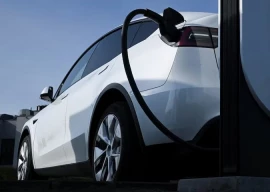
Sources told The Express Tribune that a ministerial committee, constituted to negotiate fertiliser prices with the local industry, discussed a proposal to increase fertiliser prices in the domestic market in order to bring them in line with international rates.
The proposal was aimed at generating additional revenues for offering direct subsidy to the farmers, but would also keep prices at current levels for the growers. It would help remove inefficiency, if any, in the transfer of subsidy from fertiliser manufacturers to the farmers.
The proposal was taken up by the ministerial committee in a meeting held on Monday. In the huddle, Federal Minister for Planning, Development and Special Initiatives Asad Umar along with Minister for National Food Security and Research Makhdoom Khusro Bakhtiar met with representatives of the fertiliser industry to discuss matters related to urea supply and pricing.
Committee members recommended matching domestic fertiliser prices with those in the international market by bringing gas tariffs for the industry on a par with global gas prices.
The committee proposed that the additional revenue generated could be used to provide direct subsidy for the farmers to keep fertiliser prices at current levels, which would also remove any inefficiency in the transfer of subsidy from the manufacturers to the farmers.
However, fertiliser industry sources say the proposal is a knee-jerk and discriminatory solution when compared to the incentives provided to the industry players under the Fertiliser Policy 2001.
It would widen the production cost gap between the old and new fertiliser manufacturers to the tune of over Rs1,000 per bag, they said.
Under the 2001 policy, the government provides gas to local manufacturers at the regional basket price of gas and to the new players at a fixed rate of $0.7 per million British thermal units (mmbtu) for a period of 10 years.
Such a wide difference may lead to serious market distortions and the closure of old plants, they said.
It must be realised that there was no direct correlation between LNG and urea prices as nowhere in the world urea manufacturing through LNG made economic sense, said market sources.
The officials added that there was also a psychological aspect of high prices, which would discourage the farmers from consuming urea, hence impacting the agricultural produce.
The subsidy directly transferred to the farmers may not be available to the poor ones at the time of urea purchase, considering their financial burden.
Therefore, the direct subsidy would be a complicated issue, industry sources said, adding that realisation of the Punjab government's subsidy was just 15-20% so far in spite of a simple token system.
"If the government has to switch over to direct and targeted subsidy, then Gas Infrastructure Development Cess (GIDC) must be done away with and the issue be settled out of court," an official said.
A gradual increase in gas prices combined with the proportionate subsidy tokens may be more workable to take away the onus of passing subsidy through the industry to the direct benefit scheme, they said.

















COMMENTS
Comments are moderated and generally will be posted if they are on-topic and not abusive.
For more information, please see our Comments FAQ